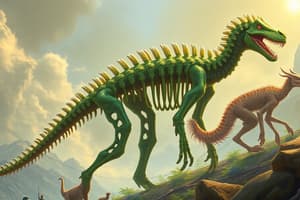Podcast
Questions and Answers
Which of the following is the best definition of phylogeny?
Which of the following is the best definition of phylogeny?
- The classification of organisms based on their physical characteristics.
- The study of how organisms develop from embryos.
- The process of natural selection leading to new species.
- The evolutionary history and relationship of an organism or group of organisms. (correct)
Homologous structures are similar in different species because of:
Homologous structures are similar in different species because of:
- Divergent evolution. (correct)
- Random mutations.
- Artificial selection.
- Convergent evolution.
Which of the following is an example of a vestigial structure?
Which of the following is an example of a vestigial structure?
- The eyes of a fish.
- The tailbone in humans. (correct)
- The legs of a horse.
- The wings of a bird.
What is the main difference between homologous and analogous structures?
What is the main difference between homologous and analogous structures?
Which type of evidence for evolution does the study of embryos provide?
Which type of evidence for evolution does the study of embryos provide?
Flashcards
Phylogeny
Phylogeny
The evolutionary history and relationships of an organism or group of organisms.
Homologous Structures
Homologous Structures
Structures that are similar in different species due to common ancestry.
Embryology
Embryology
The study of embryos and their development, showcasing homologous structures in early stages.
Analogous Structures
Analogous Structures
Signup and view all the flashcards
Vestigial Structures
Vestigial Structures
Signup and view all the flashcards
Study Notes
Bases of Evolution
- The objectives of studying the bases of evolution include explaining how both structural and developmental characteristics are used to classify living organisms. Understanding how these characteristics provide insight into the relationships and differences among species is vital to the field of biology.
- In addition to the classification of living things through structural and developmental criteria, the objectives also encompass classifying organisms based on their evolutionary evidence. This classification relies on various forms of data, including genetic makeup, fossil records, and comparative anatomy, which all contribute to our understanding of how species have evolved over time.
- A critical objective is understanding the importance of evolutionary evidence in classification. This involves recognizing that the way organisms are grouped is not arbitrary but rather reflective of their evolutionary histories. By examining similarities and differences, scientists can infer evolutionary relationships and construct more accurate classifications of organisms.
- Phylogeny refers to the evolutionary history and relationships of an organism or group of organisms. It describes the branching patterns of evolution, detailing how different species are related through common ancestors. This understanding is vital for organizing biological diversity and clarifying the connections among various life forms.
- Phylogeny elucidates relationships between organisms, such as evolutionary lineages and related species. Understanding these relationships helps in tracing the line of descent and can shed light on the characteristics that have been retained or modified throughout evolutionary time, offering insight into how current species adapt and survive in their environments.
Evidence of Evolution
- Structural evidence of evolution prominently includes homologous structures. These features are anatomical similarities in different species that arise from a common ancestor, illustrating how evolution can lead to diverse adaptations through modification of a fundamental blueprint.
- Homologous structures are specifically characterized by their similarity in form or function among different species due to their shared ancestry. This structural similarity provides compelling evidence of evolutionary relationships among organisms, highlighting how divergent evolution occurs.
- Examples of homologous structures are seen in the forelimbs of humans, cats, horses, bats, and dolphins. Despite differing functions—such as grasping, running, flying, and swimming—the forelimbs exhibit a similar underlying skeletal structure, demonstrating their common evolutionary origin.
Embryology
- Embryology is the branch of biology that focuses on the study of embryos and their development. It plays a crucial role in understanding evolutionary biology, as it provides insights into how similar embryonic stages can indicate common ancestry among diverse species.
- Some homologous structures are only visible during embryonic development, hinting at the evolutionary relationships between species. This stage is essential for the analysis of anatomical features that may not be apparent in adult forms, underscoring the concept of evolutionary development.
Analogous Structures
- Analogous structures have evolved independently in different organisms, demonstrating functional similarities that arise due to convergent evolution rather than common ancestry. These similarities can often lead to confusion when classifying organisms.
- Analogous structures emerge typically because of similar environments or selective pressures that lead to comparable adaptations despite different evolutionary paths. This process illustrates the power of natural selection in shaping the features of organisms to suit their environments.
- Examples of analogous structures include the wings of birds, bats, and insects. While these structures all serve the same primary function of facilitating flight, their evolutionary origins are distinct, and they developed through different mechanisms, showcasing the varied pathways through which evolution operates.
Vestigial Structures
- Vestigial structures are defined as anatomical features that have become non-functional or are reduced in function over time due to evolutionary changes. These structures serve as a fascinating glimpse into the evolutionary past of species.
- Vestigial structures are notable because they indicate the remnants of features that were once useful to ancestral organisms, providing evidence of the evolutionary modifications that have occurred. They highlight how evolutionary pressures can lead to the loss or alteration of previously advantageous characteristics.
- Examples of vestigial structures include reduced hind legs in certain snake species, the human appendix, goose bumps, and wisdom teeth. Each of these features illustrates how evolutionary history can lead to changes in function, as they no longer serve their original purposes in modern organisms.
Studying That Suits You
Use AI to generate personalized quizzes and flashcards to suit your learning preferences.




